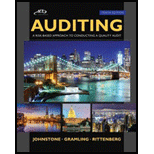
Auditing: A Risk Based-Approach to Conducting a Quality Audit
10th Edition
ISBN: 9781305080577
Author: Karla M Johnstone, Audrey A. Gramling, Larry E. Rittenberg
Publisher: South-Western College Pub
expand_more
expand_more
format_list_bulleted
Question
Chapter 6, Problem 10TFQ
To determine
Introduction: Audit evidence is proof that an auditor tries to seek from an organization in order to claim that the assertions related to financial transactions are correct.
To state: Whether the given statement is true or false.
Expert Solution & Answer
Want to see the full answer?
Check out a sample textbook solution
Students have asked these similar questions
In determining the tolerable deviation rate for a test of controls, the auditors consider:
Their planned assessed level of control risk.
The sample size.
The nature of the test.
The expected deviation rate in the population.
In assessing sample risk, alpha risks relate to the
Efficiency of the audit
Selection of the sample
Effectiveness of the audit
Audit quality controls
The type of sampling most frequently used by auditors during their study of internal control is referred to asa. Attributes sampling.b. Control sampling.c. Monetary unit sampling.d. Variables sampling.
Chapter 6 Solutions
Auditing: A Risk Based-Approach to Conducting a Quality Audit
Ch. 6 - Prob. 1TFQCh. 6 - Prob. 2TFQCh. 6 - Prob. 3TFQCh. 6 - Prob. 4TFQCh. 6 - Prob. 5TFQCh. 6 - Prob. 6TFQCh. 6 - Prob. 7TFQCh. 6 - Prob. 8TFQCh. 6 - Prob. 9TFQCh. 6 - Prob. 10TFQ
Ch. 6 - Prob. 11TFQCh. 6 - Prob. 12TFQCh. 6 - Prob. 13TFQCh. 6 - Prob. 14TFQCh. 6 - Prob. 15TFQCh. 6 - Prob. 16TFQCh. 6 - Prob. 17TFQCh. 6 - Prob. 18TFQCh. 6 - Prob. 19TFQCh. 6 - Prob. 20TFQCh. 6 - Prob. 21MCQCh. 6 - Prob. 22MCQCh. 6 - Prob. 23MCQCh. 6 - Prob. 24MCQCh. 6 - Prob. 25MCQCh. 6 - Prob. 26MCQCh. 6 - Prob. 27MCQCh. 6 - Prob. 28MCQCh. 6 - Prob. 29MCQCh. 6 - Prob. 30MCQCh. 6 - Prob. 31MCQCh. 6 - Prob. 32MCQCh. 6 - Prob. 33MCQCh. 6 - Prob. 34MCQCh. 6 - Prob. 35MCQCh. 6 - Prob. 36MCQCh. 6 - Prob. 37MCQCh. 6 - Prob. 38MCQCh. 6 - Prob. 39MCQCh. 6 - Prob. 40MCQCh. 6 - Prob. 41RSCQCh. 6 - Prob. 42RSCQCh. 6 - Prob. 43RSCQCh. 6 - Prob. 44RSCQCh. 6 - Refer to Exhibit 6.2 and describe the differences...Ch. 6 - Prob. 46RSCQCh. 6 - Prob. 48RSCQCh. 6 - Prob. 49RSCQCh. 6 - Prob. 50RSCQCh. 6 - Prob. 51RSCQCh. 6 - Prob. 52RSCQCh. 6 - Prob. 53RSCQCh. 6 - Indicate how the auditor could use substantive...Ch. 6 - Prob. 55RSCQCh. 6 - Prob. 56RSCQCh. 6 - Prob. 57RSCQCh. 6 - Prob. 58RSCQCh. 6 - Prob. 59RSCQCh. 6 - Prob. 60RSCQCh. 6 - Prob. 61RSCQCh. 6 - Prob. 62RSCQCh. 6 - Prob. 63RSCQCh. 6 - Prob. 64RSCQCh. 6 - Prob. 65RSCQCh. 6 - Prob. 66RSCQCh. 6 - Prob. 67RSCQCh. 6 - Prob. 68RSCQCh. 6 - Prob. 69FFCh. 6 - Prob. 70FFCh. 6 - Prob. 71FFCh. 6 - Prob. 72FFCh. 6 - MINISCRIBE (LO 1, 2) As reported in the Wall...
Knowledge Booster
Recommended textbooks for you
 Auditing: A Risk Based-Approach to Conducting a Q...AccountingISBN:9781305080577Author:Karla M Johnstone, Audrey A. Gramling, Larry E. RittenbergPublisher:South-Western College Pub
Auditing: A Risk Based-Approach to Conducting a Q...AccountingISBN:9781305080577Author:Karla M Johnstone, Audrey A. Gramling, Larry E. RittenbergPublisher:South-Western College Pub Auditing: A Risk Based-Approach (MindTap Course L...AccountingISBN:9781337619455Author:Karla M Johnstone, Audrey A. Gramling, Larry E. RittenbergPublisher:Cengage Learning
Auditing: A Risk Based-Approach (MindTap Course L...AccountingISBN:9781337619455Author:Karla M Johnstone, Audrey A. Gramling, Larry E. RittenbergPublisher:Cengage Learning

Auditing: A Risk Based-Approach to Conducting a Q...
Accounting
ISBN:9781305080577
Author:Karla M Johnstone, Audrey A. Gramling, Larry E. Rittenberg
Publisher:South-Western College Pub

Auditing: A Risk Based-Approach (MindTap Course L...
Accounting
ISBN:9781337619455
Author:Karla M Johnstone, Audrey A. Gramling, Larry E. Rittenberg
Publisher:Cengage Learning